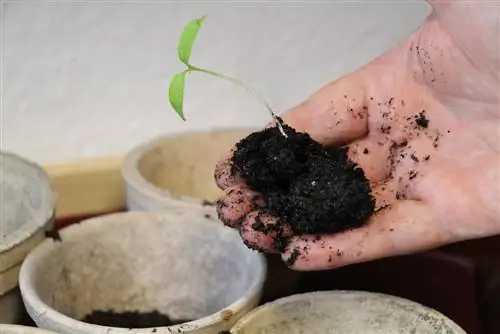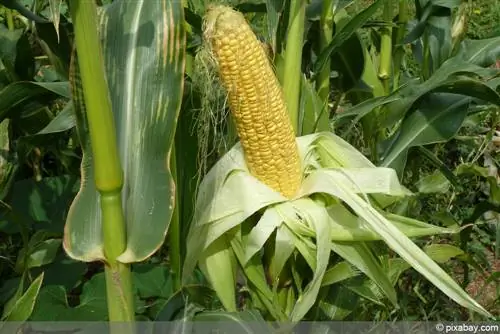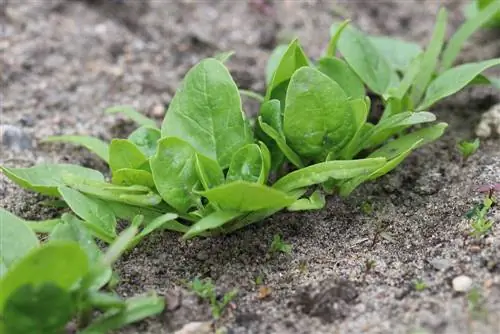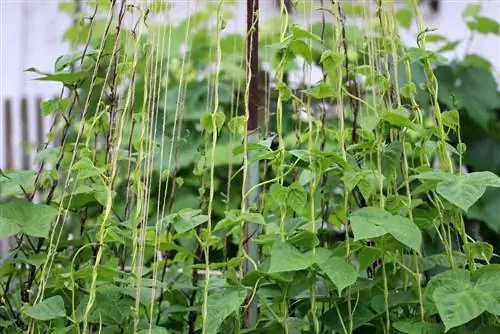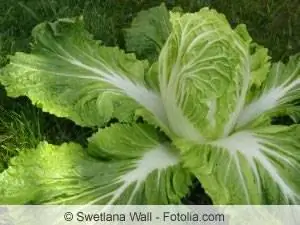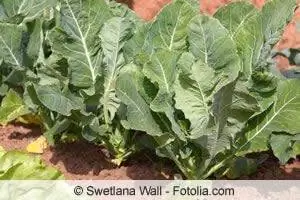- Author admin [email protected].
- Public 2023-12-17 03:39.
- Last modified 2025-01-24 12:45.
As a rule, the seeds of vegetables are sown in a planting tray and allowed to germinate in a warm place. Depending on the type of plant, it takes a few days to a few weeks for the seeds to germinate and the first leaves, called cotyledons, to appear. From now on it is important for the young vegetable plants that they have enough space.
Pricking
So that seedlings do not die and hinder each other's growth, it is important to prick them out. The term “piercing” comes from French and means “stabbing”. In the garden, pricking out basically describes nothing more than moving seedlings at a greater distance from each other or into their own pot. When pricking out, you must handle the fragile plant very carefully and make sure that the entire root is planted in the soil.
Advantages
The simplest solution would be to sow the seeds individually in small pots. This is usually not possible due to space constraints, so either several seeds are sown in a pot or in a row in the garden bed. Here the seed matures under moist and warm conditions until the seedling has made its way to the light. From now on the actual growth phase of the plant begins. The vegetables require a lot of energy. The seedlings in the seed tray compete for light, nutrients and water. So that the young lettuce, kohlrabi or pepper plants do not compete with each other for the limited supply, they are given a place in their own pot.
Right time
You should prick out seedlings at the latest as soon as the first real leaves appear after the cotyledons. In principle, vegetables should be pricked as early as possible so that they can develop optimally. If the plants are larger, they are easier to handle, but the roots are already more branched and may already be intertwined with those of the neighboring plants. This not only results in major injuries when pricking out, but the seedlings also grow more poorly in the new pot.
Sort out
Pricking out also serves to sort out small, weak or defective plants. Only allow he althy and strong seedlings to grow. Even in this early development phase, it is easy to see which of the plants have the best chance of good growth.
Substrate
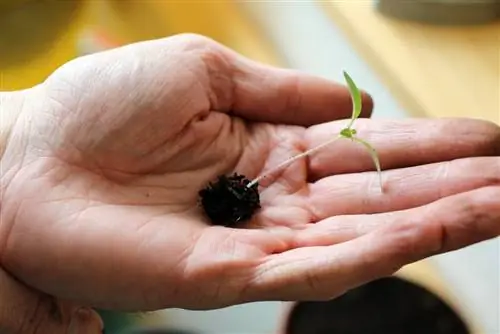
After pricking out, always use a substrate that is fine-grained and low in nutrients. Nutrient-poor substrates cause the plant to form a densely branched root system. Conventional garden soil is usually too clayey for this purpose and does not contain enough humus to support root formation.
- humos
- peat-free
- finely crumbly
- germ-free
- well permeable to water
- nutrient poor
- for example potting soil or pricking soil
Young seedlings are still very sensitive and do not have good defenses. For this reason, they are easily attacked by mold or other fungi. So make sure that the growing soil is largely germ-free.
Instructions
Basically, pricking is not difficult. However, a little tact is necessary in order not to injure the sensitive vegetable plants. In order to better remove the seedlings from the soil, it has proven useful to moisten the substrate. Basically, there are two cultivation options, in which the pricking out process also differs.
Pricking out in the garden bed
Some cold-resistant vegetable plants can be sown directly in rows in the bed. Depending on the species, certain row spacing must be maintained. Even in small areas, a larger number of vegetable plants can be sown. If small plants have formed from the seeds in spring, they must be pricked out and thinned out (warped). The best time for pricking outdoors is a cloudy but rain-free day without great heat. The following are suitable for direct sowing in beds or greenhouses:
- Spinach
- Carrots
- Turnips
- Peas
- Lamb lettuce
- Leek
- Black Roots
- Onions
- Corn
- Step 1: First, pluck out all weak, sick or poorly grown seedlings in the individual rows and dispose of them in the compost.
- Step 2: By moving individual seedlings, ensure that the desired distances in the row between the individual vegetable plants are maintained. The seedlings removed are then immediately replanted in a free spot.
- Step 3: Place the pricking stick or a garden shovel about a centimeter from the side under the first seedling and carefully lever it up a little. If the plants are very close together, the process can possibly be carried out again from the other side so that the roots of the individual seedlings separate from each other. Try to take as many of the fine roots with you as possible.
- Step 4: Using a planter or other implement such as a spoon or spatula, poke a hole for the seedling.
Distances:
Two fingers wide
- Leek
- Lamb lettuce
- Black Roots
Three fingers wide
- Carrots
- Spinach
- Sorrel
- Onions
- Radish
One handbreadth
- Corn
- Lettuce
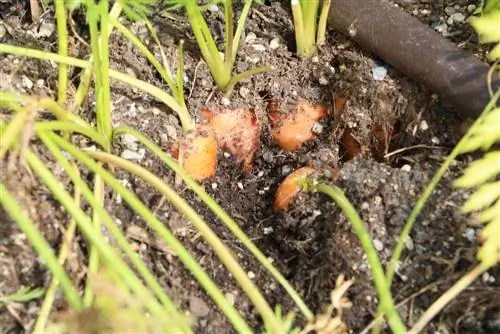
Depending on the type of vegetable, larger spacing may be necessary, for example for cabbage or beans.
Step 5: Place the young plant in the hole according to the optimal planting depth and press the soil lightly.
Step 6: A hole is now drilled at a distance of about five centimeters next to each vegetable plant and about 50 ml of water is poured into it. Don't forget to weed regularly so that the vegetables get enough light and nutrients.
Pricking out seedlings in seed trays
A whole range of vegetables are somewhat sensitive to cold and are therefore usually grown in growing trays on the windowsill. They stay in a warm house or greenhouse until no more frost is expected. Be sure to prepare a sufficient number of individual cultivation pots in advance. The plants may only be left open (without soil) for a very short period of time as they dry out quickly. That's why you should only remove and move one plant at a time.
Step 1: First fill the containers two-thirds full with potting or transplanting soil and press them down lightly.
Step 2: First sieve coarse or lumpy substrate through a coarse sieve to refine the structure.
Step 3: Fill the plant pot with the fine soil. Smooth any soil over the edge of the pot and press it down lightly.
Step 4: Drill a deep, narrow hole in the soil in the middle of the pot using the pricking rod or a wooden stick.
Step 5: Place the pricking stick from the edge as deep as possible under the first seedling and carefully lever it upwards to separate the roots of the individual seedlings from each other. Try to take as many of the fine roots with you as possible.
Step 6: Carefully remove the small plant from the substrate using your thumb and forefinger. This works best if you pull it away to the side. You must be very careful when removing it, otherwise the stems or roots will tear off.
Step 7: Very long main roots can be shortened a little. Slight injuries to the hair root always occur when pricking. If the roots are not damaged to any great extent, minor losses are not a problem; on the contrary, they even stimulate root growth.
Step 8: Place the seedling with the roots across the prepared hole in the new plant pot and then pull or press the roots into the recess. Alternatively, you can place the plant vertically in the prepared hole. It is important that the roots remain below the plant and do not bend upwards.
Step 9: Lightly press the pricking soil around the young vegetable plant and smooth the surface of the substrate.
Step 10: Repeat the above process with another seedling in a new pot.
Step 11: Water the freshly pricked vegetable plants vigorously with the fine spray on the watering can.
Planting depth
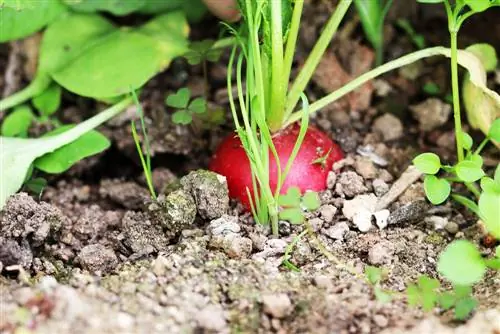
How deep the individual vegetable plants are planted depends on the type of vegetable. Many vegetables are able to form roots from the stem, creating a beautiful, compact root ball and promoting tuber or head formation.
1. Deep planting up to the first cotyledons
- Peppers and chili
- Leek
- Tomatoes
2. Plant at the same height (to promote tuber formation)
- Celeriac
- Fennel
- Salad
- Cauliflower
- Kohlrabi
How to proceed
So that the young plants can grow well, it is important to place them in a suitable place if they were planted in a pot. Vegetables such as peppers or tomatoes should be kept a little cooler after planting than when they germinated so that the plants do not grow too quickly on the windowsill due to the poor lighting conditions in early spring and develop thin, unsustainable shoots.
- bright, but without direct sun
- Temperature: 15 to 18 degrees
- keep slightly moist
If the outside temperatures allow it, the pricked vegetable plants are placed outside for an hour at a time from around the end of April. Avoid the blazing sun and heavy rain until the plants have acclimatized.
Which plants do not need to be pricked?
Not all vegetable plants require pricking. If the seeds are sown in individual pots right at the beginning, pricking out is of course unnecessary. Larger seeds or vegetables that are sensitive to transplanting are particularly suitable for individual sowing. These include:
- Tomatoes
- Cucumbers
- Peas
- Pumpkin
- Zucchini

